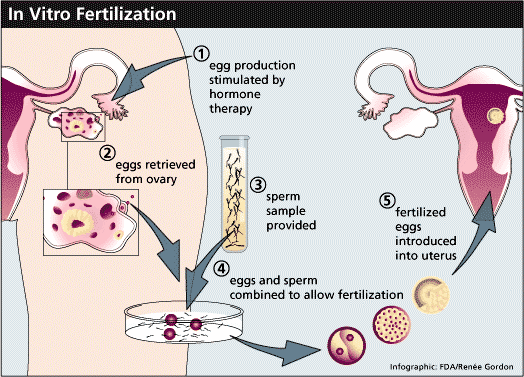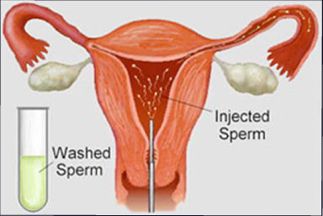Biology

Infertility is the inability of male or female to produce children.

2. Gamete Intra Fallopian Transfer (GIFT):




- Sex Determination In Animals
Sex chromosomes and AutosomesMost of the diploid organisms are with separate sexes. The organisms producing sperms are called males and those producing eggs (ova) are called females. Chromosome is the major factor to determine the sex of an organism. The...
- Comparison Between Pollination And Fertilization
Pollination and Fertilization: Major differences Pollination Fertilization 1. It is the transfer of pollen grains from anther to stigma of the flower It is the fusion of male gametes and egg cell in embryo...
- Amazing Facts About Human Reproductive System
Ø In a fetus, fingerprints are acquired at the age of 3 months (first trimester).Ø A foreskin (prepuce) from circumcised babies takes only 3 weeks to grow skin that can cover 3 basketball courts!! It can be used in treating burn patients.Ø ...
- 1. Reproduction In Organisms
Click here for PDF- Reproduction is a process in which an organism gives rise to young ones (offspring) similar to itself. - The period from birth to the natural death of an organism represents its life span. - ...
- 1. Human Reproduction
Click here for PDFReproduction is the production of young ones by an organism. Humans are sexually reproducing and viviparous. HUMAN REPRODUCTIVE SYSTEM 1. Male reproductive system It consists of Paired testes, Accessory ducts, Accessory...
Biology
Infertility and Assisted Reproductive Technologies (ART)
INFERTILITY & ASSISTED REPRODUCTIVE TECHNOLOGIES (ART)

The reasons for this may be physical, congenital, diseases, drugs, immunological or even psychological.
Assisted Reproductive Technologies (ART) are the modern techniques for the treatment of Infertility. Some techniques are given below:
1. In vitro fertilisation (IVF? test tube baby programme):
Assisted Reproductive Technologies (ART) are the modern techniques for the treatment of Infertility. Some techniques are given below:
1. In vitro fertilisation (IVF? test tube baby programme):

In this method, ova from the wife/donor and sperms from the husband/donor are collected and are induced to form zygote under simulated conditions in the laboratory. This is followed by Embryo transfer (ET). It is 2 types:
- Zygote Intra Fallopian Transfer (ZIFT): It is the transfer of zygote or early embryos (with up to 8 blastomeres) into fallopian tube.
- Intra Uterine Transfer (IUT): It is the transfer of embryos with more than 8 blastomeres into the uterus.
2. Gamete Intra Fallopian Transfer (GIFT):

It is the transfer of an ovum from a donor into the fallopian tube of another female who cannot produce ovum, but can provide suitable environment for fertilization and development.
3. Intra cytoplasmic sperm injection (ICSI):
3. Intra cytoplasmic sperm injection (ICSI):

It is the a laboratory procedure in which a single sperm (from male partner) is injected directly into an egg (from female partner). Then the fertilised egg is implanted into the woman?s uterus.
4. Artificial insemination (AI) technique:
4. Artificial insemination (AI) technique:

The semen collected from the husband or a healthy donor is artificially introduced into the vagina or the uterus (IUI ? intra-uterine insemination) of the female.
This technique is useful for the male partner having inability to inseminate female or low sperm counts etc.
5. Surrogacy:
5. Surrogacy:

Here, a woman (surrogate mother) bears a child for a couple unable to produce children, because the wife is infertile or unable to carry.
The surrogate is impregnated either through artificial insemination or through implantation of an embryo produced by in vitro fertilisation.
Problems of ART
Problems of ART
- It requires high precision handling by specialized professionals and expensive instrumentation. Therefore, these facilities are available only in very few centres.
- It has emotional, religious and social problems.
- Sex Determination In Animals
Sex chromosomes and AutosomesMost of the diploid organisms are with separate sexes. The organisms producing sperms are called males and those producing eggs (ova) are called females. Chromosome is the major factor to determine the sex of an organism. The...
- Comparison Between Pollination And Fertilization
Pollination and Fertilization: Major differences Pollination Fertilization 1. It is the transfer of pollen grains from anther to stigma of the flower It is the fusion of male gametes and egg cell in embryo...
- Amazing Facts About Human Reproductive System
Ø In a fetus, fingerprints are acquired at the age of 3 months (first trimester).Ø A foreskin (prepuce) from circumcised babies takes only 3 weeks to grow skin that can cover 3 basketball courts!! It can be used in treating burn patients.Ø ...
- 1. Reproduction In Organisms
Click here for PDF- Reproduction is a process in which an organism gives rise to young ones (offspring) similar to itself. - The period from birth to the natural death of an organism represents its life span. - ...
- 1. Human Reproduction
Click here for PDFReproduction is the production of young ones by an organism. Humans are sexually reproducing and viviparous. HUMAN REPRODUCTIVE SYSTEM 1. Male reproductive system It consists of Paired testes, Accessory ducts, Accessory...
